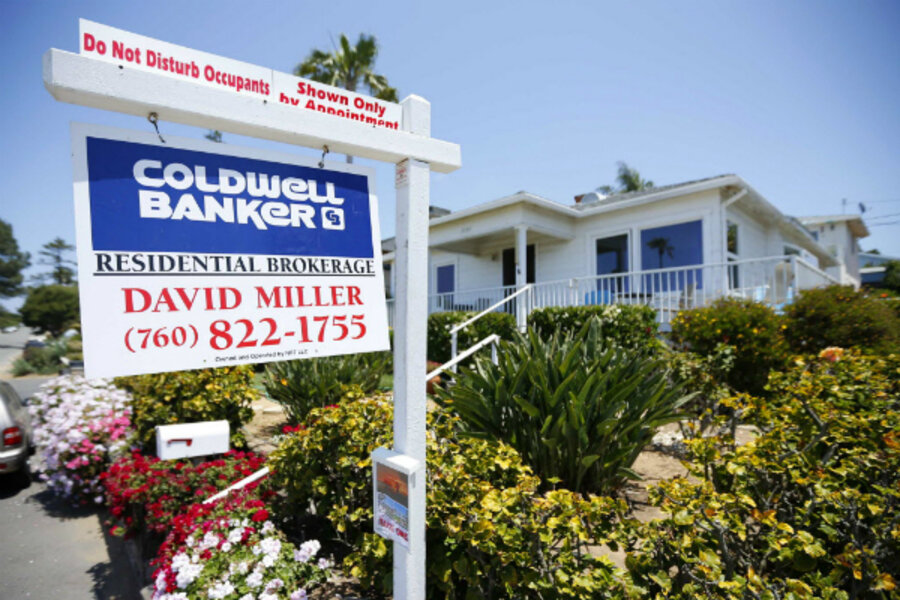US mortgage rates tick downward again: Good news for home prices?
Loading...
First the good news: Mortgage interest rates ticked downward for a second straight week. But it’s still been a volatile ride in recent months, and the general direction of interest rates for home loans has been up.
What does that mean?
If you’re a home buyer, that means the money you’ve budgeted for housing doesn’t go as far, in terms of the price you can offer to pay.
If you’re a home seller or home owner, a spike in interest rates can sometimes stall or even reverse the trend of rising home values. But the damage of rising interest rates doesn’t appear to be as bad as you might expect. History tells the tale, as we’ll see in a moment.
As of Thursday, the latest average interest on a 30-year fixed-rate loan is 4.31 percent a year, according to the firm Freddie Mac. That’s down from 4.51 percent two weeks ago.
Still, current US mortgage rates are also up a full percentage point from where they stood back in January. So the fact that their upward race has stalled, for a couple of weeks at least, is welcome news for the housing market.
"Mortgage rates eased for the second consecutive week which should help to alleviate market concerns of a slowdown in the housing market,” Frank Nothaft, chief economist of Freddie Mac, said in a statement released with the weekly mortgage data. “Existing home sales for June were the second highest since November 2009 and new home sales were the strongest since May 2008.”
The progress in the housing market is important for the whole economy, providing some important fuel at a time when gross domestic product is growing only modestly.
Home prices have been rising, boosting consumer wealth, and construction jobs have been aided by a relative shortage of homes for sale.
Many economists say modestly rising mortgage rates aren’t likely to stop the housing recovery. For one thing, mortgage rates are still historically low.
History suggests that moves in mortgage rates can exert an influence on home prices – in the opposite direction. But in some cases the damage isn’t very bad.
Consider two times since 1971 when mortgage rates rose rapidly: the period from 1978 to 1981, and 1994.
Thirty-five years ago, the rate on a 30-year fixed mortgage surged upward from 9.01 percent in January 1978 to 18.45 percent by late 1981. Importantly, inflation was also running hot at this time, eroding the purchasing power of a dollar.
The “real” price of homes (in inflation-adjusted dollars) sagged some 7 percent during that period. That’s not a huge plunge, but this era of high interest rates and inflation seemed to have long-lasting effects: It was 1987 before the real home prices, as tracked by economist Robert Shiller of Yale University, got back to their 1978 level.
In 1994, the rate on a 30-year loan jumped from 7.07 percent in January to 9.20 percent in December.
Like today, the economy then was in the early phases of recovery from a recession. Home prices weren’t rising much before 1994. With the overall economy improving, the 1994 rate jump didn’t trigger a notable home price decline, but real home prices stayed pretty flat for about three years, even though mortgage rates started easing downward again.
In both these episodes, the Federal Reserve was in a “tightening” mode on monetary policy – raising short-term interest rates. During first period, in particular, the Fed was battling runaway inflation until the economy fell into a deep recession in 1981.
Today, the rise in interest rates has more to do with expectations than action by the Fed. A rise in so-called taper talk by Fed officials has spawned worry about a potential shift in monetary policy.
The concern is that the central bank will soon start to taper the pace of a bond-buying program aimed at lowering long-term interest rates and spurring economic growth. Fed Chairman Ben Bernanke has tried to take the edge off these fears, by saying that the Fed’s policy will still be very “accommodative,” with ultra-low short-term interest rates, until the unemployment rate has fallen substantially.
The moral of this history lesson: Mortgage rates aren’t the only thing that drives house prices, but rates are worth paying attention to.
Home values are also influenced importantly by a range of factors, from trends in the job market and incomes to things like the supply of homes for sale and whether banks are being easy or tight in approving loans.
An advantage of buying a home, even at a time when the general trend in rates may be upward, is locking in a relatively low rate.
A risk, judging by history, is that rising mortgage rates sometimes contribute to a climate in which home price gains are hard to come by for a while.






